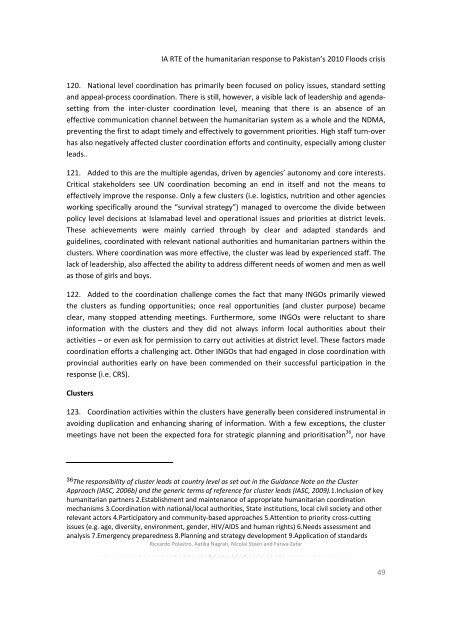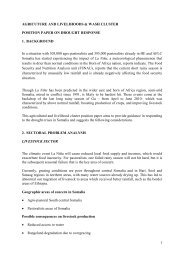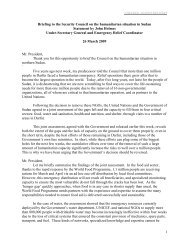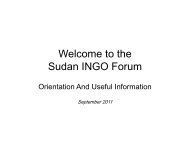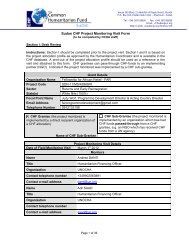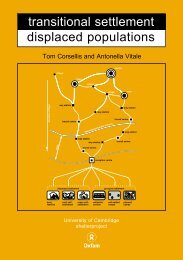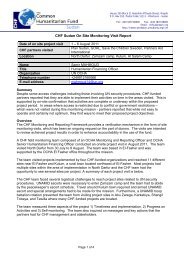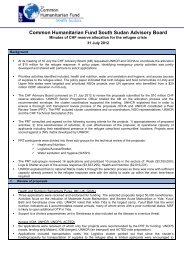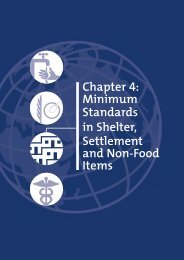Inter-Agency Real Time Evaluation of the Humanitarian ... - OCHANet
Inter-Agency Real Time Evaluation of the Humanitarian ... - OCHANet
Inter-Agency Real Time Evaluation of the Humanitarian ... - OCHANet
You also want an ePaper? Increase the reach of your titles
YUMPU automatically turns print PDFs into web optimized ePapers that Google loves.
IA RTE <strong>of</strong> <strong>the</strong> humanitarian response to Pakistan’s 2010 Floods crisis<br />
120. National level coordination has primarily been focused on policy issues, standard setting<br />
and appeal‐process coordination. There is still, however, a visible lack <strong>of</strong> leadership and agenda‐<br />
setting from <strong>the</strong> inter‐cluster coordination level, meaning that <strong>the</strong>re is an absence <strong>of</strong> an<br />
effective communication channel between <strong>the</strong> humanitarian system as a whole and <strong>the</strong> NDMA,<br />
preventing <strong>the</strong> first to adapt timely and effectively to government priorities. High staff turn‐over<br />
has also negatively affected cluster coordination efforts and continuity, especially among cluster<br />
leads..<br />
121. Added to this are <strong>the</strong> multiple agendas, driven by agencies’ autonomy and core interests.<br />
Critical stakeholders see UN coordination becoming an end in itself and not <strong>the</strong> means to<br />
effectively improve <strong>the</strong> response. Only a few clusters (i.e. logistics, nutrition and o<strong>the</strong>r agencies<br />
working specifically around <strong>the</strong> “survival strategy”) managed to overcome <strong>the</strong> divide between<br />
policy level decisions at Islamabad level and operational issues and priorities at district levels.<br />
These achievements were mainly carried through by clear and adapted standards and<br />
guidelines, coordinated with relevant national authorities and humanitarian partners within <strong>the</strong><br />
clusters. Where coordination was more effective, <strong>the</strong> cluster was lead by experienced staff. The<br />
lack <strong>of</strong> leadership, also affected <strong>the</strong> ability to address different needs <strong>of</strong> women and men as well<br />
as those <strong>of</strong> girls and boys.<br />
122. Added to <strong>the</strong> coordination challenge comes <strong>the</strong> fact that many INGOs primarily viewed<br />
<strong>the</strong> clusters as funding opportunities; once real opportunities (and cluster purpose) became<br />
clear, many stopped attending meetings. Fur<strong>the</strong>rmore, some INGOs were reluctant to share<br />
information with <strong>the</strong> clusters and <strong>the</strong>y did not always inform local authorities about <strong>the</strong>ir<br />
activities – or even ask for permission to carry out activities at district level. These factors made<br />
coordination efforts a challenging act. O<strong>the</strong>r INGOs that had engaged in close coordination with<br />
provincial authorities early on have been commended on <strong>the</strong>ir successful participation in <strong>the</strong><br />
response (i.e. CRS).<br />
Clusters<br />
123. Coordination activities within <strong>the</strong> clusters have generally been considered instrumental in<br />
avoiding duplication and enhancing sharing <strong>of</strong> information. With a few exceptions, <strong>the</strong> cluster<br />
meetings have not been <strong>the</strong> expected fora for strategic planning and prioritisation 36 , nor have<br />
36The responsibility <strong>of</strong> cluster leads at country level as set out in <strong>the</strong> Guidance Note on <strong>the</strong> Cluster<br />
Approach (IASC, 2006b) and <strong>the</strong> generic terms <strong>of</strong> reference for cluster leads (IASC, 2009).1.Inclusion <strong>of</strong> key<br />
humanitarian partners 2.Establishment and maintenance <strong>of</strong> appropriate humanitarian coordination<br />
mechanisms 3.Coordination with national/local authorities, State institutions, local civil society and o<strong>the</strong>r<br />
relevant actors 4.Participatory and community‐based approaches 5.Attention to priority cross‐cutting<br />
issues (e.g. age, diversity, environment, gender, HIV/AIDS and human rights) 6.Needs assessment and<br />
analysis 7.Emergency preparedness 8.Planning and strategy development 9.Application <strong>of</strong> standards<br />
Riccardo Polastro, Aatika Nagrah, Nicolai Steen and Farwa Zafar<br />
49


